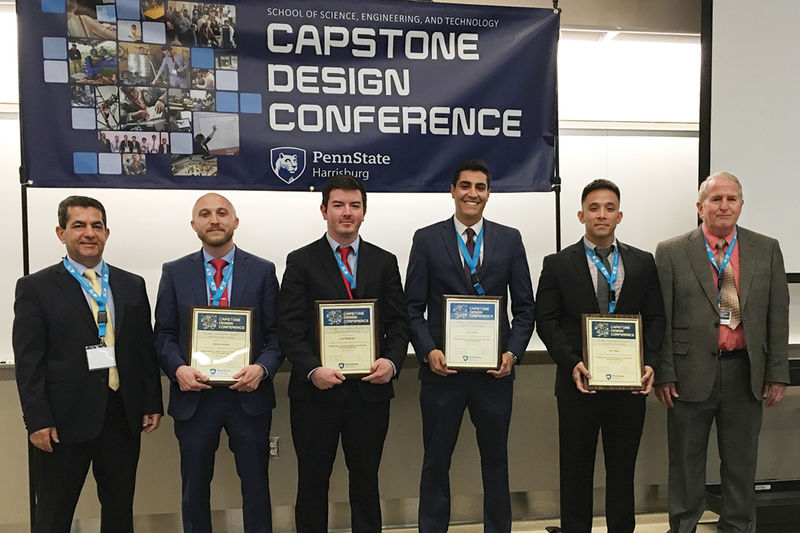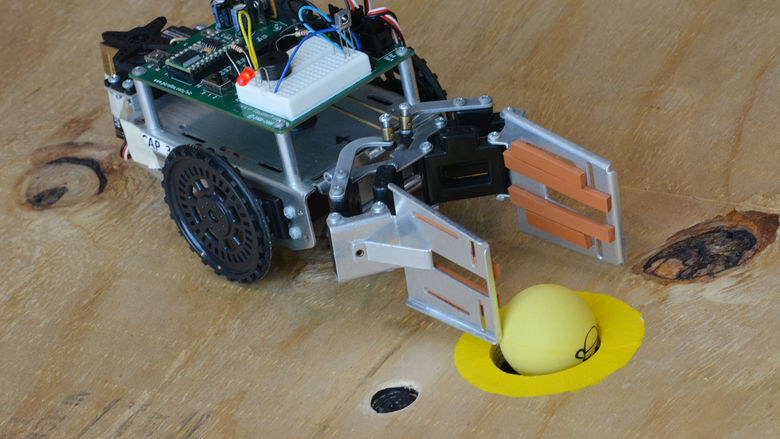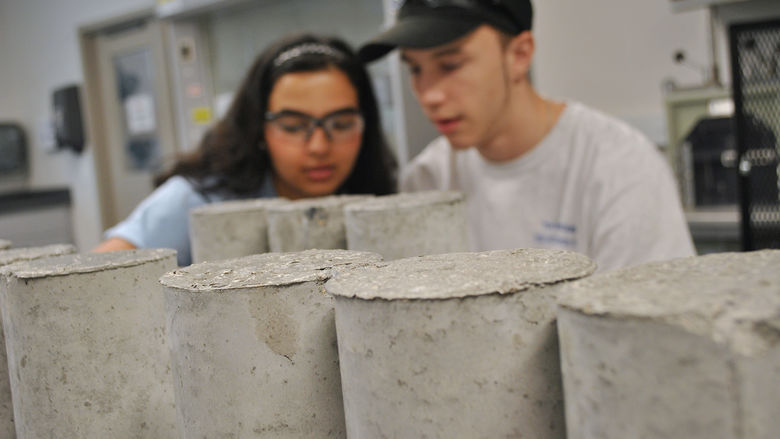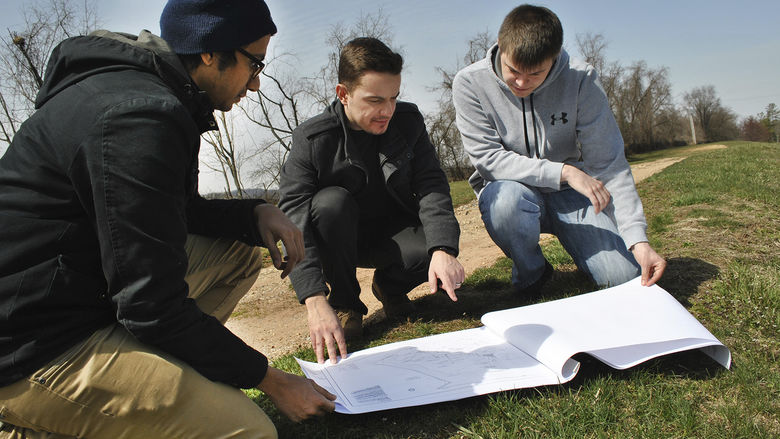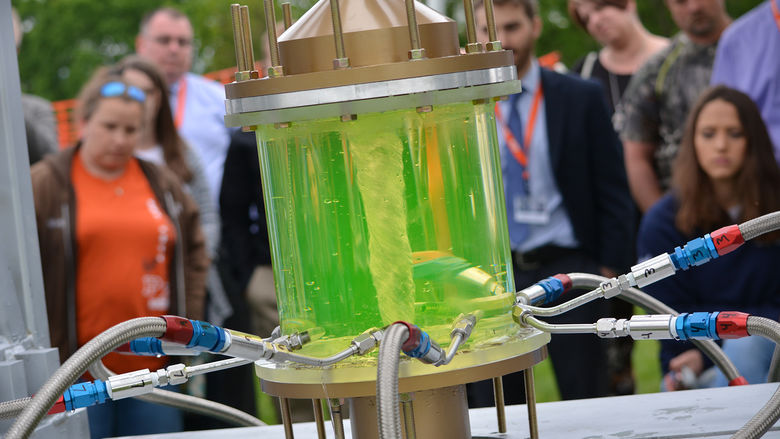
Students who won the James A. Andrews Memorial Award for Excellence in Capstone Design designed a personalized 3D printed implant for a pediatric cancer patient with bone loss. Prototypes of the implant were 3D printed from both a plastic material and titanium alloy.
HARRISBURG, Pa. — Outstanding student projects were recognized during the recent Penn State Harrisburg School of Science, Engineering, and Technology Capstone Design Conference. The conference is the culmination of students’ undergraduate studies and provides the opportunity to combine classroom learning with real-life applications, as well as collaborate with industry sponsors.
Judges selected winners from several program categories: civil engineering and structural design/construction engineering technology; electrical engineering and electrical engineering technology; computer science; mechanical engineering and mechanical engineering technology; and multi-disciplinary.
Awards were given to outstanding group projects based on the criteria of overall appearance and quality of display; overall professional appearance of presenters; effectiveness of display, support materials and experimental set-ups; project summary by the team or individual; interaction with visitors; and innovation. Each program had its own judges.
For the first time this year, the school also offered a sponsored award in the amount of $1,000. The James A. Andrews Memorial Award for Excellence in Capstone Design recognizes and encourages students who best demonstrate interest, motivation and ability in identifying and solving an engineering problem that addresses a real-world concern. It is intended to honor students who couple creative approaches with practical ability to successfully resolve a situation.
The award was established by the family of James "Jim" Andrews, who was an alumnus of Penn State and worked as a senior field support engineer for Rockwell Automation in York, Pennsylvania, in admiration of Andrew’s flexible, can-do spirit. The award will be presented every year. The winner of this award was chosen from among the first-place winners in each category.
The winners included:
Civil Engineering, Structural Design and Construction Engineering Technology
Project: Green Infrastructure - Ash Recycling and Processing Facility Construction
Sponsors: York County Solid Waste and Refuse Authority and Barton & Loguidice, D.P.C.
Group Members: Sergio Aguilar, Matthew Baker, Mason Brandt, Jacob Fenby, Jared Harbold, Jaryd Olweiler and Nicholas Vereb
Faculty Advisers: Shashi Marikunte, Saravanan Gurupackiam, and Roger Subramanian
The students developed a green infrastructure for the Ash Recycling and Processing Facility Construction, located in York, Pennsylvania. The addition of the green infrastructure, skylights, and solar roofing tiles at the facility will provide employees a place to escape the atmosphere of the processing floor, reduce water runoff, allow natural light to infiltrate the facility’s processing areas, and efficiently utilize the expansive roof system through collecting energy and reducing the facility’s resource consumption.
Electrical Engineering, Electrical Engineering Technology
Project: Drowsiness Detection System
Group Members: Raghu Acharya and Raja Suryadevara
Faculty Adviser: Aldo Morales
Students developed a drowsiness detection system that helps prevent accidents caused by tired drivers. This system detects drowsiness and alerts the driver in real time. Although companies like Mercedes, Toyota and Ford have systems to detect drowsiness in newer cars, there is no standard product on the market that can be retrofitted to older cars. Also, there are new cars from many companies that do not have such a system. This project aims to solve that problem.
Computer Science
Project: KittyPath Assistant
Group Members: Abderrazzak Asmaayni, Jakub Grzegorzewski, Joseph Hernandez, Joshua Holden, Azalee Mcalpine and Neil Pasricha
Faculty Adviser: Linda Null
Students developed KittyPath Assistant, a Google Chrome extension that will help students utilize planning features that Penn State Harrisburg offers. It helps gather information the student can use to schedule courses, view their suggested degree plan, search through courses, view degree requirements and more. KittyPath Assistant provides all these features in an easily navigable package. Advisers will also be able to use the assistant to help students with their questions and provide advice based specifically on a student’s needs.
The James A. Andrews Memorial Award for Excellence in Capstone Design, and Mechanical Engineering, Mechanical Engineering Technology
Project: Personalized 3D Printed Implant for Pediatric Oncology Bone Loss
Sponsors: Four Diamonds and Penn State Health Milton S. Hershey Medical Center
Group Members: Joshua Adams, Ali Elakkari, Alex Preniczky and Phu Trinh
External Advisers: Gregory Lewis and Edward Fox (Penn State Milton S. Hershey Medical Center)
Faculty Adviser: Anilchandra Attaluri
Students designed a personalized 3D printed implant for a pediatric cancer patient with bone loss. What typically happens in these cases is that the cancerous bone segment has to be removed; the students developed a structural replacement for that removed bone. MRI scans were used to reconstruct a computer design model of the thighbone just above the knee joint. Prototypes of the implant were 3D printed from both a plastic material and titanium alloy.
Multi-disciplinary Project
Project: 3D Scanning Drone
Group Members: Tyler Benner, Matthew Maisano, Joshua Smay and James Then
Faculty Advisers: Ola Rashwan, Mohammad Tofighi and Scott van Tonningen
Students designed and constructed a quadcopter drone with a camera that is capable of independent flight, imaging, and three-dimensional scanning. Images captured are sent wirelessly to a computer that converts them into a 3D model. The goal of such a drone is to aid in the inspection of structures, such as bridges and water towers. The students said that their motivation for pursuing this project was the current decline and aging of bridges in the U.S. and the need for more inspections. Their quadcopter drone would save money and manpower by reducing the need to hire more workers to inspect bridges.
